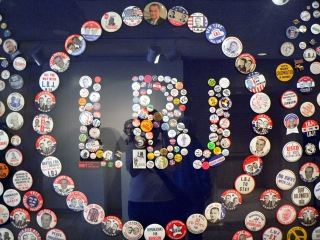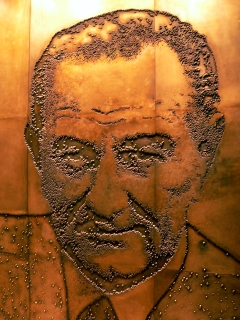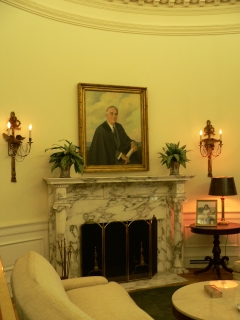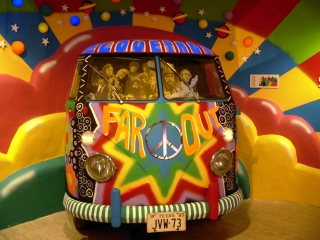Lyndon B. Johnson Library and Museum
Austin, Texas
Visited: February 23, 2005
NPS Site Visited: Not an NPS Site
Presidential Library Visted: 7 of 12
Local Website
 WHAT IS IT? WHAT IS IT?
The Presidential Library and Museum of our 36th president, Lyndon Baines Johnson.
BEAUTY (2/10)
The LBJ Library is an unbearably ugly eight-story travertine structure. It looks like a giant white version of the nightstand that budget hotels put between two double beds. The top floor juts out on all sides over the buildings first seven floors furthering the tabletop imagery.
HISTORIC SIGNIFICANCE (6/10)
LBJ presided over a singularly compelling period of American history, a time whose themes threateningly recur and whose battles are still being fought. The Museum successfully throws you back into the era but only analyzes it superficially. It is up to you to delve further.
CROWDS (6/10)
The crowds were large but evenly disbursed. We did not have to wait to use any of the interactive displays.
 EASE OF USE/ACCESS (5/5) EASE OF USE/ACCESS (5/5)
LBJís Library is located along the eastern edge of the University of Texas campus near downtown Austin and in the shadow of Darrell Royal-Texas Memorial Stadium. The Site is less than a ľ mile from Exit 235B of Interstate 35. Parking is free. There are many signs but be careful. Austin traffic is dense; the town seems to have grown too fast.
CONCESSIONS/BOOKSTORE (5/5)
The Bookstore carries a large number of books written about LBJ, many of which have won the Pulitzer Prize. A remarkable number of authors have utilized the wealth of information documented at the LBJ Library. Because the Site is an academic magnet regarding 60ís research, most of the books for sale here have been autographed by their author. The bookstoreís emphasis is on the written word rather than presidential knickknacks.
COSTS (5/5)
The LBJ Museum is the only Presidential Library that does not charge an admission fee.
RANGER/GUIDE TO TOURIST RATIO (2/5)
A few docents who aimed to help were situated at the front desk and throughout the Museum.
 TOURS/CLASSES (7/10) TOURS/CLASSES (7/10)
The exhibits begin at LBJís birth in small town hill country Texas. These sparingly informative floor-to-ceiling displays show events in LBJís life and are paired with a general world timeline and numerous black and white photos. Johnsonís great strength as a Senate leader is unfairly understated; we would have liked to learn more about the man pre-Presidency.
The Museum pathway leads you into a narrow corridor and the Siteís most powerful display the entire original hand-written note from Jacqueline Kennedy to LBJ after her husbandís assassination. The note is extremely moving. It is hard to think of anything else for the next hour or so. The portions of the Museum that discuss the Great Society and the War on Poverty are a blur. History has treated LBJ the same way, only remembering JFK to the detriment of Lyndonís social crusade.
The exhibits detailing Johnsonís social programs, passage of the Voting Rights Acts and role in the Civil Rights struggle are placed in the back of the first floor, tucked away and forgotten by most tourists. The 1966-68 displays are out in the open along the left side and receive most of the traffic. Terse recaps recount the Vietnam War, the rioting American inner cities, the assassinations of Martin Luther King, Jr. and Bobby Kennedy and the nightmare year of 1968.
There is not nearly enough space for these displays. Any academic distancing has already been lost because of the many tragic black and white photographs. It is hard to understand what happened to America during this disturbing time. LBJ did not know and the Museum does not make an attempt to justify its subject or explain the confounding years.
The explanation does come upstairs in the form of a traveling exhibit called "Signs of the Times: Life in the Swingin' Sixties". This tremendous and engaging display is a perfect companion piece to the LBJ Museum, exactly opposite in every way. It is colorful, interactive, exciting, rebellious, loud and joyful and a perfect explanation of the times that LBJ never understood.
Signs of the Times rarely mentions Johnson but is perhaps more vital than the rest of the Museum in understanding his Presidencyís successes and failures.
 FUN (6/10) FUN (6/10)
Signs of the Times is F-U-N fun. All areas of pop culture are covered. We spent at least 20 minutes watching a truncated version of A Hard Dayís Night in the Mod Cinema Theater. The Good, the Bad and the Ugly, Dr. Strangelove, Dr. No and The Graduate were also being shown in the comfortable viewing room. Another room was decorated as a nightclub where a television set played loops of 60ís stand-up comics like Bill Cosby and Woody Allen. Had to keep it safe for the kids, we suppose. Interactive TV sets allowed us to watch snippets from The Smothers Brothers, Laugh-In, That Girl, Batman and many others. Other rooms were dedicated to Motown, Mod Music, Psychedelica, Pop Art, Literature and renegade sports heroes like Clyde Frazier and Joe Namath.
The LBJ Museum was drab and did not have the spirit of the vibrant Signs of the Times. The permanent Museum was a place of tragedy and sorrow. Even the animatronic Lyndon telling humorous west-Texas tall tales seemed profoundly sad.
WOULD WE RECOMMEND? (7/10)
Go before the Signs of the Times exhibit leaves in August 2005 or hope that the Museum curators decide to keep it on permanent display.
TOTAL 51/80
|